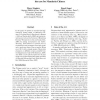Free Online Productivity Tools
i2Speak
i2Symbol
i2OCR
iTex2Img
iWeb2Print
iWeb2Shot
i2Type
iPdf2Split
iPdf2Merge
i2Bopomofo
i2Arabic
i2Style
i2Image
i2PDF
iLatex2Rtf
Sci2ools
ACL
2012
2012
Unsupervized Word Segmentation: the Case for Mandarin Chinese
In this paper, we present an unsupervized segmentation system tested on Mandarin Chinese. Following Harris's Hypothesis in Kempe (1999) and Tanaka-Ishii's (2005) reformulation, we base our work on the Variation of Branching Entropy. We improve on (Jin and Tanaka-Ishii, 2006) by adding normalization and viterbidecoding. This enable us to remove most of the thresholds and parameters from their model and to reach near state-of-the-art results (Wang et al., 2011) with a simpler system. We provide evaluation on different corpora available from the Segmentation bake-off II (Emerson, 2005) and define a more precise topline for the task using cross-trained supervized system available off-the-shelf (Zhang and Clark, 2010; Zhao and Kit, 2008; Huang and Zhao, 2007)
| Added | 29 Sep 2012 |
| Updated | 29 Sep 2012 |
| Type | Journal |
| Year | 2012 |
| Where | ACL |
| Authors | Pierre Magistry, Benoît Sagot |
Comments (0)

